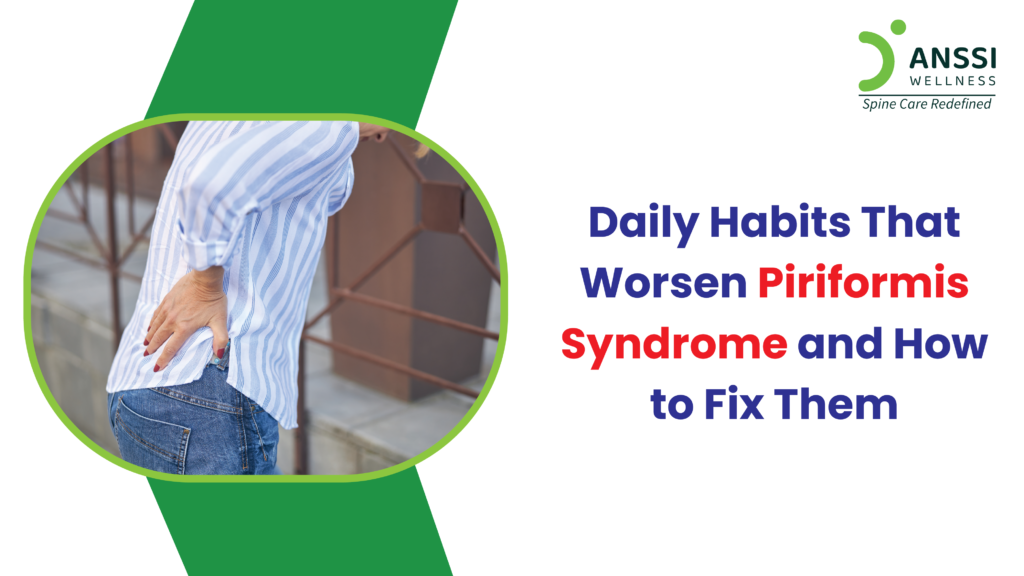Piriformis Syndrome is a painful neuromuscular condition that occurs when the piriformis muscle, located deep in the buttocks, compresses or irritates the sciatic nerve. This condition can lead to pain, tingling, or numbness in the buttocks, and the discomfort often radiates down the leg, mimicking symptoms of sciatica.
What many people don’t realise is that every day habits can unknowingly make this condition worse. From how we sit to how we move, our daily routines can trigger or intensify piriformis-related pain.
Common Habits That Aggravate Piriformis Syndrome
Understanding the following bad habits is the first step toward relieving discomfort and improving spinal health.
Prolonged Sitting
Sitting for extended hours, especially on hard or uneven surfaces, keeps the piriformis muscle in a shortened position. This continuous tension can lead to tightness and muscle spasms, increasing pressure on the sciatic nerve. It’s a common problem among office workers, drivers, and anyone with a sedentary lifestyle.
Poor Posture
Bad posture while sitting or standing shifts the body’s alignment and increases strain on the lower back and pelvic region. Slouching, crossing legs, or leaning heavily to one side can irritate the piriformis muscle and further compress the sciatic nerve.
Lack of Stretching
Avoiding stretching exercises causes muscle stiffness and reduces flexibility. A tight piriformis muscle lacks the elasticity needed to move freely, making it more prone to spasms and compression of nearby nerves.
Over-exercising or Improper Workouts
Excessive physical activity without proper form or warm-up can lead to inflammation of the piriformis muscle. High-impact workouts, abrupt movements, or heavy leg exercises may strain this muscle, causing pain flare-ups and delayed recovery.
Climbing Stairs Repeatedly
While climbing stairs is a good form of cardio, repetitive stair-climbing without proper form can overstress the gluteal and piriformis muscles. This repetitive strain contributes to muscle irritation and nerve compression.
Lifting Heavy Objects Incorrectly
Lifting weights or heavy objects without engaging the core or maintaining proper posture can overload the lower back and buttocks. This form of strain can irritate or inflame the piriformis muscle, especially if done repeatedly or with poor technique.
How to Fix These Habits
Try to be mindful of the following parts of your routine.
1. Ergonomic Sitting Setup
Use ergonomic chairs that support the natural curve of your spine. Sit with both feet flat on the floor and your knees at hip level. Consider using a cushion for better support and take standing breaks every 30–45 minutes to reduce pressure on the piriformis muscle.
2. Daily Stretching
Incorporate gentle piriformis stretches into your routine. Some effective stretches include:
- Supine piriformis stretch
- Seated spinal twist
- Figure-four stretch
Stretching increases flexibility, reduces muscle tension, and enhances blood circulation.
3. Correcting Posture
Whether sitting, standing, or walking, keep your back straight, shoulders relaxed, and core engaged. Avoid slouching and crossing your legs. You can also consult a physiotherapist to learn posture correction exercises tailored to your body.
4. Proper Warm-Up and Recovery
Always warm up before exercising to prepare the muscles for movement. Cooling down after workouts helps prevent stiffness. Focus on strengthening the core and glutes to reduce dependency on the piriformis muscle during movement.
5. Limit Stair Use and Improve Technique
If climbing stairs aggravates your symptoms, reduce the frequency or switch to an elevator when possible. When using stairs, step up gently and push through your entire foot rather than your toes to distribute the pressure evenly.
6. Practise Safe Lifting
Bend your knees—not your back—when lifting heavy objects. Keep the object close to your body and use both hands. Avoid twisting while lifting, and engage your core to reduce strain on the spine.
Management and Treatment of Piriformis Syndrome
While correcting daily habits plays a vital role in managing piriformis syndrome, some individuals may still need definite treatment. Fortunately, there are non-invasive and safe treatment options available.
Exercise-Based Management
Low-impact aerobic activities help keep the muscles active without triggering flare-ups. Recommended options include:
- Stationary Biking: Maintains hip mobility and gently strengthens leg muscles.
- Walking: Promotes blood flow and spinal alignment.
- Water Aerobics or Swimming: Provides resistance without pressure, reducing strain on the piriformis and spine.
These exercises relieve pain, improve flexibility, and support long-term recovery.
Non-Surgical Spine Treatments
- Medication: One common approach is medication. Over-the-counter anti-inflammatory drugs such as ibuprofen can help reduce inflammation and pain. In some cases, muscle relaxants may be prescribed to ease muscle spasms and improve mobility.
- Massage Therapy: It is another powerful tool. Deep tissue massage can release tension in the piriformis muscle, improve blood flow, and relieve pressure on the sciatic nerve. Trigger point therapy, in particular, helps break down muscle knots that contribute to chronic pain.
- Physical therapy: It plays a key role—targeted stretches and strengthening exercises help release tension in the piriformis muscle and improve posture.
- Heat/Cold Therapy: Heat therapy relaxes tight muscles, while cold therapy reduces inflammation and numbs sharp pain.
These simple methods, when done consistently, can provide lasting relief. Early intervention and lifestyle changes are crucial to prevent chronic discomfort and avoid invasive procedures.
About ANSSI:
ANSSI Wellness focuses on improving the quality of life for patients suffering from spinal issues, aiming to provide relief where other conventional treatments have failed. Through advanced non-surgical spinal decompression treatment, ANSSI is committed to helping patients avoid surgery and recover in a safe, effective, and compassionate environment.
Connect with ANSSI Wellness on LinkedIn, Instagram, and Facebook for expert guidance.



